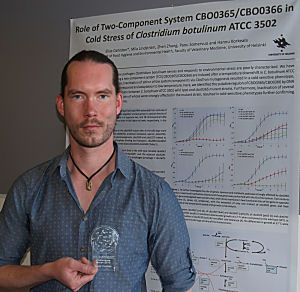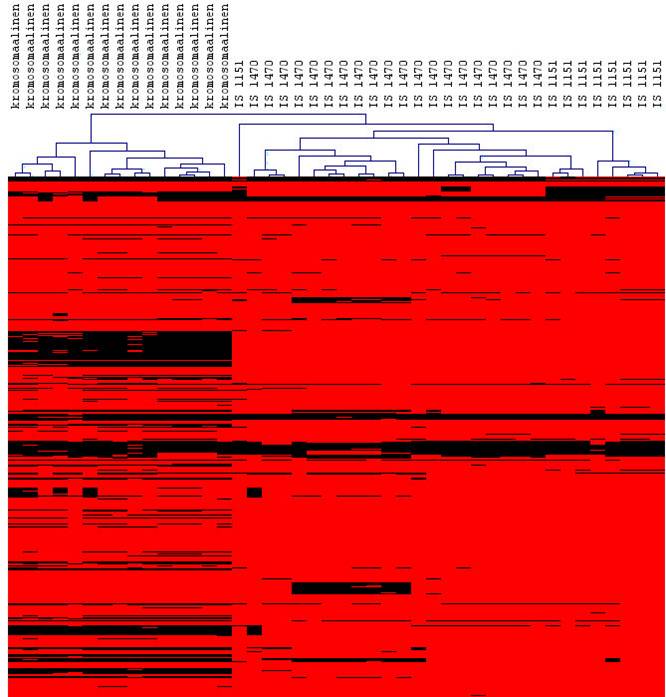In the industrialized world the bacterium Campylobacter jejuni is most commonly the cause of bacterial intestinal disease. In Finland, in 2011, 4262 cases were registered at THL, although the real number of cases is predicted to be much higher. Of the infections in Finland approximately 2/3 are imported from foreign countries.
The symptoms of the disease incl ude diarrhea (sometimes bloody), fever, vomiting and headache. Infections may occur 3-7 days after ingestion of the bacterium. The majority of infections are not part of an outbreak. Therefore, it is often hard to find a source of an infection.
ude diarrhea (sometimes bloody), fever, vomiting and headache. Infections may occur 3-7 days after ingestion of the bacterium. The majority of infections are not part of an outbreak. Therefore, it is often hard to find a source of an infection.
The bacterium is carried by a lot of animal sources, which usually do not develop clinical symptoms. Especially chickens carry a lot of C. jejuni, although compared to the rest of Europe; Finnish chickens carry very few campylobacters. In addition to chickens C. jejuni has also been found from cows and geese. Cats and dogs could also carry the bacterium.
Finally, C. jejuni can be found in the environment, especially in water.
In order to find a link between the sources of human infections and the human infections itself certain methodology called multilocus sequence typing (MLST) can be used. This method distinguishes the isolates on a genetic level and generates sequence data. These sequences are translated to a numerical output, a sequence type (ST). The sequence data can be analysed and modeled mathematically (for example by Bayesian modeling, such as BAPS) which groups the isolates, from which we can estimate the relative source attribution to human infections of each source.
Human and broiler strain genotypes frequencies evolved in different directions

De Haan and colleagues used the MLST methodology to group C. jejuni isolated from human infections, acquired in the Helsinki-Uusimaa region, and those of potential sources including chickens, cows, geese and natural water bodies. “We looked how the genetic pool of C. jejuni changed over the years and compare these changes in different hosts. We first looked at the human and chicken C. jejuni isolates and how their populations changed in a 10-year time period (1999-2006). We found many common C. jejuni types between the two hosts, but we also found opposite trends of some types between the two hosts. For example, in the human host ST-677 became less relevant for infection toward the end of the study period, whereas in chickens this type was found in increasing numbers each year.” De Haan tells about the study. “At the end of our study period, the total overlap of similar types between the human and chicken C. jejuni isolates had decreased 20%.
Source attribution of human infections
By making use of MLST and BAPS we determined that both poultry and water seemed to be the most likely sources of infection when the disease was acquired in Finland. However, especially in the C. jejuni isolates from water some strange types appeared as well, indicating that not all the C. jejuni present in water seems to be able to infect humans.”
The types from the bovine and the wild bird C. jejuni isolates were mostly found in a different group from the humans, chickens and waters. Part of the human C. jejuni isolates did cluster with the bovines, although this association was not as strong compared to those of the chickens and water.
Strains with a different genetic makeup can cause infections
De Haan looked at potential virulence properties (FspA, GGT, AnsBs and FucP) to see if these could be found in their C. jejuni strain collection. A statistically significantly association of FspA1 with patient isolates was found. Also, statistically significantly associations of FspA with certain sequence types was found and it is possible that FspA plays a role in the adaptation to and colonization of different hosts; this was especially prominent in the CC ST-48. The other examined properties showed a heterogeneous distribution among different sources and STs. This suggests that their role in adaptation, colonization and pathogenesis is not critical.
MSc Astrid de Haan academic dissertation was presented, with the permission of the Faculty of Veterinary Medicine, Univerity of Helsinki, for public examination in Helsinki on 28th of September 2012.
Title of thesis is “Molecular typing and source attribution of Finnish Campylobacter jejuni isolates” and it belongs to the field of environmental health.
The opponent was professor Dr. Birgitta Duim (Utrecht University, Netherlands) and the custos was professor Marja-Liisa Hänninen.
An electronic version of the dissertation.







